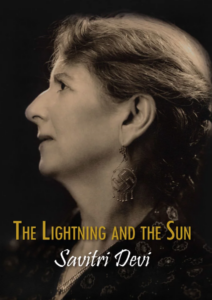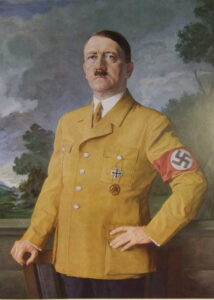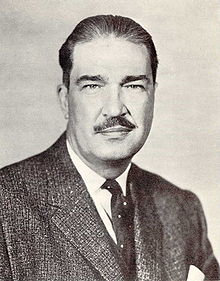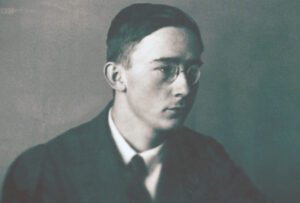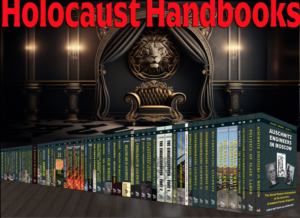 Here I am, gazing at the Brandenburg Gate a dozen days ago. I’ve just returned home after a trip to several countries in continental Europe, including Germany. In the coming days, I’ll be writing a series of articles, hopefully with an incendiary tone, about what I saw…
Here I am, gazing at the Brandenburg Gate a dozen days ago. I’ve just returned home after a trip to several countries in continental Europe, including Germany. In the coming days, I’ll be writing a series of articles, hopefully with an incendiary tone, about what I saw…
Author: C .T.
and the Sun, 11
It is written in Mein Kampf:
Poison can only be overcome through counter-poison, and only a shallow bourgeois mind can consider the middle line as the way to Paradise.[1]
A philosophy filled with infernal intolerance will only be broken through a clear and absolutely true new idea animated with the same spirit and defended with the same tremendous will-power.
One may, today, well regret that, in the Ancient World, which was much freer than ours, the first moral terror appeared with the coming of Christianity; one cannot, however, put in doubt the fact that the world has been, since then, dominated and oppressed through tyranny, and that tyranny can only be broken through tyranny, and terror through terror. Then only can new conditions — constructive ones — be created.
[Emphasis by Ed.]Political parties are inclined to compromise; creeds, never. Political parties take contradictors into account; creeds proclaim their own infallibility.[2]
That which gave Marxism its success was the perfect collaboration of political will and militant brutality. That which prevented national Germany from moulding German evolution was the absence of a decisive collaboration of brutal force and of the political will of a man of genius.[3]
The conviction that one has the right to use even the most brutal weapons always goes hand in hand with fanatical faith in the necessity of the victory of a revolutionary new order upon this earth.
A movement that is not fighting for such high aims and ideals, will therefore never resort to the most extreme means (or weapons).[4]
These and other such sentences (there are many more in what one could call the Book of the new Aryan faith) define with amazing exactitude the National Socialist Movement as an upheaval ‘against Time,’ and point out the fundamental difference between Adolf Hitler and all such great historical figures as I have, in these pages, described as men ‘above Time’ and men ‘in Time’ — ‘Sun’ men, and ‘Lightning’ men. They glaringly show how foolish it is to compare the Founder of National Socialism with Napoleon — as so many have done — or to accept the well-meant but no less erroneous — though by far less popular — description which a few of his English followers have boldly given of him as a ‘political Christ.’ [5]
Napoleon is but the pocket edition of Genghis Khan. Yet — considered from the cosmic standpoint — he is a man of the same sort as he: a war-lord and an organiser who put his genius to the service of his family and of nothing more, not, by any means, because he saw, or thought he could see, in it, the vehicle of some great impersonal Idea, but simply because it was his. In other words: a man altogether ‘in Time.’ Men ‘in Time’ either have no ideology at all and do not pretend to have any, or they pretend to serve a faith ‘above Time’ or ‘against Time’ and exploit the latter for their own ends (like all the false Christians who fought for themselves in God’s name, and all the false National Socialists for whom the struggle under the Swastika Flag was only a means to work themselves into power) or else — like the sincere Marxists — they have an Ideology which is, itself, an Ideology ‘in Time’; an Ideology which is in contradiction with the divine final y of Creation, and therefore expresses the will of the Death-forces. […]
Adolf Hitler is a typical Man ‘against Time’ — like Rama, like Lord Krishna, the most widely remembered Aryan heroes who fought and ruled in India already before, or at the dawn of, this Dark Age, and, nearer to us, like the very noblest Figure of the Arab world, the Prophet Mohamed. As I said in the beginning of this book, all real great men ‘against Time’ are, ultimately, also ‘above Time,’ inasmuch as any ideal of integral Perfection is necessarily timeless. In other words, that towards which the great men ‘against Time’ strive — Adolf Hitler like the others — is ‘God’; Perfection beyond Time as the Archetype and Principle of that perfect, tangible life-order which they seek to bring — to bring back; or rather to hasten back; — into the world. But they thoroughly know that no changes upon this earth, and especially no changes in the direction of primaeval Perfection in and, which is more, at the end of this Dark Age, can be brought about without violence. They know — infallibly — that, the more the Forces of disintegration and death are successful, i.e., the more the Dark Age is advanced, the more violence is indispensable in order to break the current of decay [emphasis by Ed.]; at least in order to stand in the way of the rush of Time, as a witness (and an active precursor) of the coming glorious Dawn of the next Time-cycle. And they accept that physical necessity. Contrarily even to those men ‘above Time’ who, such as Akhenaton of Egypt, dream of an earthly ‘Kingdom of God,’ they are prepared to make use of violence — of ‘utmost brutality,’ to quote Adolf Hitler’s own words — to the extent it is to forward the sacred purpose: ‘the destruction of evil-doers and the establishment on earth of the reign of Righteousness,’ of which it is spoken in the Bhagavad-Gita; the foundation of the socio-political order which is ‘in harmony with the original meaning of things’ — true to the eternal cosmic Order — as again Adolf Hitler has, with, crystal-clear insight, understood and proclaimed.
The very fact of historical existence — existence within Time — sets a dilemma before all those who already strive towards Perfection; they must either turn their backs to this world of strife altogether, and seek the timeless inner Kingdom of Peace, which is not of this earth; or, if that which they want be an earthly paradise, seek it, by all means, against the current of Time; against the formidable and ever-increasing pressure of the Death-forces throughout any Time-cycle and, specially near the end of one, but then, far from renouncing violence, fight the Forces of disintegration with the self-same ruthless weapons as they use; with violence; with the impact of quantity; and, if necessary — if expedient — even with lies; with the weapons of the Dark Age, the only ones which can and will match theirs.
For centuries, perhaps for millenniums — perhaps ever since the day Lord Krishna proclaimed upon the Kurukshetra battle-field the Gospel of detached Violence, creed of every hero ‘against Time’ — no man has understood that dilemma so clearly, and faced it with such boldness and such consistency as Adolf Hitler [emphasis by Ed.]. And unless one also understands it; unless one at least realises that it is a dilemma — i.e., that one cannot go both ways and that, after one has chosen, one is to tread the path to its end — one will behold neither the evolution of National Socialism (before 1933; between 1933 and 1945; and after 1945) not the history of the Second World War, which is narrowly connected with it, nor the subsequent history of our times, in the proper light. And any judgement one might, then, pass, will be false from the cosmic — and a fortiori from the historical — point of view.
___________
[1] Mein Kampf, p. 371.
[2] Mein Kampf, p. 507.
[3] Mein Kampf, p. 596.
[4] Mein Kampf, p. 597.
[5] The expression was used by Molly Stamford, an English woman detained during the war under the 18 B act.
______ 卐 ______
The Lightning & the Sun by Savitri Devi (Counter-Currents Publishing, 2014, unabridged edition) can be ordered here.
Christianity
and the survival of the West, 1
by Revilo Oliver (1973)
Contents
The Religion of the West
The Orient
Christianity Today
The Predictable Future
The Consequences
Succedaneous Religion
Postscript
The mission of this generation is the most difficult that has ever faced a Western generation. It must break the terror by which it is held in silence, it must look ahead, it must believe when there is apparently no hope, it must obey even if it means death, it must fight to the end rather than submit… The men of this generation must fight for the continued existence of the West.
—Francis Parker Yockey (1948)
Chapter One: THE RELIGION OF THE WEST
YOU, WHO ARE NOW reading these lines, and I are strangers. I have no means of knowing whether you are a Christian or an atheist. That, however, will not matter, so long as we talk about facts and not wishes.
The observed and verifiable facts of the world about us are not affected by religious faith or the lack of faith. Christians and atheists must find themselves in perfect agreement when they affirm that lead is more malleable than steel, that the earth is an oblate spheroid rotating on its axis, that whales are mammals, that Germany was defeated and devastated by the many nations allied against her in 1945, and that the Chinese are Mongolians. About such matters there can be no dispute among Western men, who instinctively accept the reality of the world about us and cannot believe, as do many Orientals, that it is merely an illusion in the mind of a dreamer.
If we would salvage and restore our civilization—the Occidental culture that is peculiarly our own and that now seems to be disintegrating and rotting before our very eyes—we must do so as Western men, by observing reality objectively and by reasoning from it dispassionately. And when we try to compute what resources remain to us, we need first of all to determine the actual strength of the Christian tradition at the present time.
It is a fact, which Christians will regard with satisfaction and some atheists may deplore, that Western civilization, for about half of its recorded history, has been a Christian civilization in the sense that the great majority of the people belonging to it (though never, at any time, all of them) believed implicitly in the truth of the Christian revelation. That religious unanimity was for a long time so nearly complete that, after the fall of the Roman Empire and the evanescence of hopes for its restoration, we of the West regarded our religion as the bond that united us and distinguished us from the rest of the human species. During the Middle Ages, our ancestors occupied the greater part of Europe, and, until they discovered the American continents, they lived only in Europe, but despite that geographical unity, they did not generally refer to themselves as the Europeans. For all practical purposes, furthermore, our ancestors belonged to the same division of the white race: they, like the true Greeks and the true Romans before them, were all members of the great race that we now call Indo-European or Aryan, but they had in their languages no word to designate their blood relationship and biological unity. Thus, when they referred to the unity of which they were always conscious as something transcending the constantly shifting territorial and political divisions of Europe, they called themselves Christendom. And for many centuries that word was adequate and misled no one.
For many centuries the West was Christendom and its civilization was indubitably Christian: that, whether you like it or not, is an historical fact. There is a complementary historical fact that was less obvious at the time and that even thoughtful men overlooked or tried to ignore until the events of the past two decades made it indubitable: Christianity is a religion of the West, and, for all practical purposes, only of the West. It is not, as its polemical adversaries so often charge, a Semitic cult, for it has never commanded the adhesion of any considerable number of Semites, and it is not, as Christians once generally believed, a universal religion, for experience has proved that it cannot be successfully exported to populations that are not Indo-European.
Experience has also proved that it does not do the slightest good to deny ascertained facts. The men of Classical antiquity knew, of course, that the earth is spherical, and Eratosthenes in the third century B.C. calculated its circumference as 24,663 miles. But the early Fathers of the Church, living in the age of growing ignorance that shrouded the last century of the Roman Empire, decided, on the basis of some statements in the Old Testament, that the earth ought to be flat or, at least, no more curved than a shield. Lactantius was the most eloquent and probably, therefore, the most influential of the many who assiduously demanded that the earth be flat and so imposed on their contemporaries the conviction that it was. In the Middle Ages, to be sure, there were some learned men, such as Buridan, who knew that the globe is a globe, but they, like learned men today, who all know very well that talk about the equality of races is utter nonsense, usually refrained from publicly denouncing fashionable delusions. It was not until the Fifteenth Century that the truth became again inescapable, but when it did, the Christians, being men of the West, who do not deny the lessons of experience, surrendered the comfortable error in which they had once generally believed; and since that time, no rational Christian has doubted that the earth is spherical.
Today, as in the Fifteenth Century, Western men have had to discard a congenial assumption to bring their conception of the world into conformity with observed reality. So long as we of the West held unquestioned dominion over the whole earth, we permitted ourselves to assume that our civilization in general, and our religion in particular, could be exported and made universal. We did not sufficiently observed that talent for mimicry is common to all human beings and indeed to all anthropoids; that all human beings stand in awe of those who have power over them; and that a genius for dissimulation and hypocrisy is hereditary in the most intelligent Orientals. Even with these oversights, the evidence against our assumption was fairly clear, but in the pride of our power we felt that we could indulge an assumption that was so congenial to the romantic generosity that is a peculiarity of our race. But the events of half a century, and especially of the last two decades, have shown us, beyond peradventure of doubt, the shape of the world in which we live. We now know what our prolonged missionary effort, cultural as well as religious, accomplished—and how its visible effects were produced.
When Cortés and his small but valiant band of iron men conquered the teeming empire of the Aztecs, he was immediately followed by a train of earnest missionaries, chiefly Franciscans, who began to preach the Gospel to the natives and soon sent home, with naive enthusiasm, glowing accounts of the conversions they had effected. Their pious sincerity and innocent joy still lives in the pages of Father Sahagun, Father Torquemada, and many others. For their sake I am glad that the poor Franciscans never suspected how small a part they played in the religious conversions that gave them such happiness. Far, far more persuasive than their sermons and their book had been the Spanish cannon that breached and shattered the Aztec defenses, and the ruthless Spanish soldiers who slew the Aztec priests at their own altars and toppled the Aztec idols from the sacrificial pyramids. The Aztecs, Tepanecs, and other natives accepted Christianity, not because their hearts were touched by alien and incomprehensible doctrines of love and mercy, but because it was the religion of the white men whose bronze cannon and mail-clad warriors were invincible.
That was early in the Sixteenth Century and even then there were not wanting indications that should have given pause to a critical mind, but we of the West went on repeating that fond mistake for four centuries, as the missionaries whom we sent to all parts of the world wrote home glowing reports of the number of “hearts” they had “won for Christ.” It was only after our enemies’ campaign of “anti-colonialism” really got under way that most of us realized that what had won all those hearts was primarily the discipline of British regiments and the manifest power of the white man.
We now know what happened. On many a shore of Africa, for example, missionaries eager to “win souls for Christ” ventured to land alone, and the aborigines, after mutilating and torturing them for a good communal laugh, ate them, cooked or raw according to the custom of the local cuisine. Usually, a few weeks or a few months later, a British cruiser hove to off shore and lobbed half a dozen 4.5 shells into the native village, and, if not pressed for time, landed half a company of marines to beat the bushes and drag out a dozen or so savages to hang on convenient trees. Consequently the tribe, if not very obtuse, took the hint and respected the next bevy of missionaries as somehow representing the god of thunder and lightning. And if the men of God distributed enough free rice and medical care with their sermons, they were able to make “converts,” as the natives learned to utter the words that Christians like to hear.
That is, in essence, the whole history of “winning souls” among the savages. There were, of course, many local variations. If the first missionaries were preceded by troops or white settlers, the blacks had already been convinced of the virtues of Christian rifles and had learned that white men should not be regarded as esculent comestibles. It often happened, however, that the natives, even after many years of preaching and conversion, rejected the white man’s odd rites very emphatically, and a fresh supply of missionaries was needed. In 1905, for example, the Maji-Maji conspiracy in Tanganyika murdered all the missionaries and almost all the white men and women in the entire territory, and it required a German regiment and several companies of marines to restore the teachings of the Gospel. That was done by giving some forty or fifty thousand demonstrations that a Mauser bullet could penetrate even a black hide that had been most carefully anointed with the grease of a boiled baby.
The Christian missionaries did teach a ritual and often inculcated a superstition that had some superficial resemblance to their religion, but as for teaching the spiritual substance of Christianity, they might as well have followed the example of St. Francis and preached sermons to the birds. That is why the many, many thousands of devoted Christians who expended their whole lives to “save souls” built only an edifice of cardboard and tinsel that is now gone in the wind.
What the vanishing of that flimsy facade has made obvious was predictable from the first. The religion of the West has never been comprehensible to the rudimentary minds of Congoids, Capoids, and Australoids, races so primitive that they were congenitally incapable of inventing a wheel and even of using one without supervision—races that could not develop for themselves even the first and simplest preliminaries of a civilization. When the missionaries invented systems of writing the crude languages of the primitives, they had also to invent words to express such concepts as “God,” “soul,” “justice,” “morality,” and “religion”—invent them by either creating new words or by perverting to such meanings sounds that in the native jargons conveyed impressions that were faintly and remotely analogous. That fact alone should have made us think. It was clear, furthermore, that the “converts,” even those who had been most thoroughly imbued with an awe of the god of repeating rifles and locomotives, would conform to the white man’s morality only under coercion, and that whenever they escaped from the white man’s supervision they spontaneously reverted not only to their own mores but also to whatever form of voodoo they had practiced before. Even if earlier experience had not been conclusive, what happened in Haiti at the very beginning of the Nineteenth Century should have removed the last lingering doubt. But the missionaries did not learn, and the “Ladies’ Missionary Society” went on contributing their mites, plying their needles, and glowing with tender emotion for the sweet little savages depicted by their romantic imaginations.
Although it is true that in some places in the former colonial possessions missionaries are still tolerated, if they are obsequious to the natives and pay very well, we have at last learned that the Gospel follows the British regiments in the white man’s ignominious and insane retreat from the world that was his.
True Himmler, 11
I exaggerated last Saturday when I said that David Irving’s True Himmler was only about Heinrich’s childhood and adolescence. I have read on and it has a few sentences worth quoting. If the senior figures of the Third Reich were heroes or saints for the ‘dissident’ right it would still be possible to save the Aryan from inexorable extinction. But they are not: many of them still have legendary Jews as their heroes!
Yesterday, for example, I was shocked to find that both Alexander Mercouris, who vlogs in his English channel (here), and three well-known Spanish ‘dissidents’ in the YouTube subculture (here), talked about Good Friday as if my very Christian father were still alive and educating the teenager I was half a century ago!
Just as white nationalists in general ignore Carrier’s critique of the NT regarding Romulus—a critique that could very well be used to validate Kevin MacDonald’s approach to subversive Jewry—, the so-called dissidents haven’t emerged from the bubble they introjected from their ancestors.
So back to Himmler, for although Heini received a strict Catholic upbringing as a child, as an adult he was able to transvalue his values. I think that on this point Maurice is right in saying that we need more Holocaust affirmers in the movement: something that couldn’t contrast more with the heavy chains with which Christian ethics, in both its traditional and neochristian versions, undermines the Aryan collective unconscious.
On page 72 of True Himmler Irving informs us that Heini disliked beer (I dislike it too). Two pages later we read: ‘Easter will be very nice and cheerful’, Heini wrote to his mother. In another letter, dated May 1921, Heini wrote to his mother that he had visited Salzburg by bicycle, where he went to church. At the age of twenty-one Himmler still felt at home with his pious parents and among the Catholic architecture of St Michael’s, the largest Renaissance church in the Alps. He particularly loved the royal Hofkirche for its ornaments and Old Testament frescoes: the church of All Saints where his cousin sometimes celebrated mass. Heini was such a good boy that he went to the eight o’clock mass one Sunday morning and wrote to his mother about his experiences in that church.
On page 90 we learn that Heini’s first contact with incipient National Socialism wasn’t with Hitler, but with the homosexual Ernst Röhm, who invited him to join the movement. However, Heini was always repulsed by such behaviour and didn’t join the movement—yet.
Adolf Hitler was older than Himmler, and at that time he was already saying things like: ‘We need a dictator who is a genius if we are to arise again’. I wonder how many white nationalists know that democracy is shit and that only a tough dictator could save them? Speaking in Salzburg, Hitler was already demanding the extirpation of the ‘Jewish bacillus’ from Austria and Germany (pages 93-94). ‘For us, this is not a problem to which you can turn a blind eye, one to be solved by minor concessions… Don’t be misled into thinking you can fight a disease without killing the carrier, without destroying the bacillus’. And on the same page of Irving’s book we can read:
‘We must be fired with a remorseless determination to grasp this evil at its roots and exterminate it, root and branch’. A few weeks later he repeated, ‘We cannot skirt around the Jewish Question. It has got to be solved’.
In 1923 hyperinflation hit Germany and only the Jews got richer having bought houses, land and works of art: which motivated the people to listen to radical voices, like Uncle Adolf’s. We can imagine why I believe that now the American dollar is the one that has to hyperinflate!
Just as many on the racial right deny the Holocaust, others deny that Hitler and Himmler wanted to conquer the lands of the half-gooks for the Aryans. On page 119 Irving again quotes Hitler:
Germany’s future lay in the east. ‘The destruction of the Russian empire and the distribution of its land and property, which will be settled by Germans…’
And on page 122 he does it again:
‘A solution of the Jewish Question is bound to come. If it can be resolved with common sense [the Madagascar Plan], so much the better’. If not, he predicted, there were two or more possibilities — ‘either the Armenian, Levantine, way or bloody confrontation’. In 1915 the Turks had brutally expelled the Armenians…
A few words later Irving ends the ninth chapter of True Himmler.
Eureka!
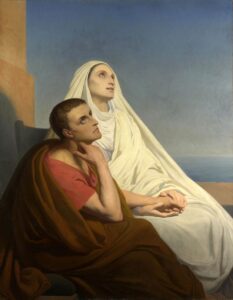 I am not finished with what I recently said about St Augustine. For the faithful, the crucial event in Augustine’s conversion happened when, at random, he picked up an epistle of Paul and read a verse that struck him like a bolt of lightning.
I am not finished with what I recently said about St Augustine. For the faithful, the crucial event in Augustine’s conversion happened when, at random, he picked up an epistle of Paul and read a verse that struck him like a bolt of lightning.
Augustine was the architect of the Dark Ages. It is high time for Daybreak: exactly the opposite regarding the Jesus myth that persists in quite a few quarters of the American racial right.
From the video ‘Bible scholars leave Christianity’ (which is over 10 hours long!), the eureka moment I like the most is this moment of reverse conversion. While reading an ancient ‘pagan’ text, a Bible scholar realised that Evangelists of later times had plagiarized the legends of Jesus from the story of Romulus, the God of the Romans.
Hitler’s speeches
– II –
WHY ARE WE ANTISEMITES? (Aug 1920)
Thanks to the magic of AI translators, it’s now possible to hear Hitler’s speeches in the Führer’s voice, albeit in English:
Just after the 40-minute mark, it’s clear that Hitler rebels against the New Testament commandment to turn the other cheek (when the Jew hit us). He says the correct thing to do is to slap him several times for every slap we receive.
It should be obvious to the American racial right: The Semitic author of the Gospel who puts in the mouth of Jesus a commandment to love your enemy is your enemy.
Future historian
I own the Holocaust Handbooks series on DVDs: the Holocaust deniers’ point of view.
On the other hand it is true what I said in previous posts: I also own a seminal treatise of almost fifteen hundred pages that represents, among others, the orthodox view in academia that the Holocaust was historical.
True, I have skimmed both versions, but obviously I won’t read all the material on either side!
To do so I would have to be fifty years younger and, moreover, an institution would have to pay for such research, whereas a fair hearing of the ‘deniers’ and ‘affirmers’ would take many years.
To give just one example. Some affirmers rely on German documents and testimonies of the alleged victims while some deniers physically analyse, say, the rooms where Zyklon-B was allegedly spread in Auschwitz’s gas chambers. A denier may rationalise away the evidence of documents and testimonies. At the same time, an affirmer may not answer the scientific analysis that a denier did in the gas chambers of Auschwitz.
Parallel universes are thus created in which there is no communication between the two groups.
Trying to break that from a neutral point of view requires not only youth, but also funds for research. It is not enough, one denier would say, that Mark Weber and David Irving—who starred in the denialist movement some decades ago—, have in their later years come closer to the position of the affirmers (because of German documents at the time of the Final Solution). The affirmers, it is said, have to refute point by point the deniers’ scientific and statistical analyses (the enormous volume of bodies that are claimed to have been incinerated in the extermination camps).
That can only be done by a neutral team without thoughtcrime laws, and research would take years. Even if I magically took half a century off my shoulders, and an academic institution gave me a grant to study the so-called Holocaust neutrally, I wouldn’t be able to produce convincing results. The claims of some deniers have to be honestly addressed and researched in labs by specialists in chemistry and the logistics of mass corpse cremation.
If the European system’s demand that I must believe the Holocaust as an article of faith or be thrown in jail is irrational, it is also irrational that I have to doubt it simply because there is the collection of denier books pictured above!
As I said, it would take not only decades but also a great deal of dedication from several historians and scientists to undertake teamwork and delve into this topic at an expert level.
I hope that, after the coming dollar collapse (and thus of the euro and all fiat currencies), the West will be liberated to such a degree that future generations of historians will be able to study the so-called Holocaust rationally.
1945 (XVII)
 If possible, Germans in French hands suffered even more than those held by Americans. When France requested slaves as part of its war booty, Eisenhower transferred over half a million Germans east.
If possible, Germans in French hands suffered even more than those held by Americans. When France requested slaves as part of its war booty, Eisenhower transferred over half a million Germans east.
“Gee! I hope we don’t ever lose a war,’’ thought a GI as he stared at the broken, starving wrecks being selected for slavery. At one American camp of over 30,000 prisoners, a stunned French officer was horrified to see nothing but a vast killing field, “peopled with living skeletons, male and female, huddling under scraps of wet card board.”
Martin Brech happened to be in a truck slowly following one group of Germans that were marching toward France and slavery. “Whenever a German prisoner staggered or dropped back, he was hit on the head with a club and killed,” recalled the shocked US private. “The bodies were rolled to the side of the road to be picked up by another truck. For many, this quick death might have been preferable to slow starvation in our killing fields.”
“When we marched through Namur in a column seven abreast, there was also a Catholic procession going through the street,” remembered one slave as he moved through Belgium. “When the people saw the POWs, the procession dissolved, and they threw rocks and horse shit at us. From Namur, we went by train in open railroad cars. At one point we went under a bridge, and railroad ties were thrown from it into the cars filled with POWs, causing several deaths. Later we went under another overpass, and women lifted their skirts and relieved themselves on us.”
Once in France, the assaults intensified. “We were cursed, spat upon and even physically attacked by the French population, especially the women,” Hans von der Heide wrote. “I bitterly recalled scenes from the spring, when we marched American POWs through the streets of Paris. They were threatened and insulted no differently by the French mob.”
Like the Americans, the French starved their prisoners. Unlike the Americans, the French drained the last ounce of labor from their victims before they dropped dead. “I have seen them beaten with rifle butts and kicked with feet in the streets of the town because they broke down of overwork,” remarked a witness from Langres. “Two or three of them die of exhaustion every week.”
“In another camp,” a horrified viewer added, “prisoners receive only one meal a day but are expected to continue working. Elsewhere so many have died recently that the cemetery space was exhausted and another had to be built.”
Revealed the French journal, Le Figaro: “In certain camps for German prisoners of war… living skeletons may be seen… and deaths from undernourishment are numerous. We learn that prisoners have been savagely and systematically beaten and that some have been employed in removing mines without protection equipment so that they have been condemned to die sooner or later.”
“Twenty-five percent of the men in our camp died in one month,” echoed a slave from Buglose.
The enslavement of German soldiers was not limited to France. Although fed and treated infinitely better, several hundred thousand POWs in Great Britain were transformed into virtual slaves. When prisoners were put to work raising projects for Britain’s grand “Victory in Europe” celebration, one English foreman felt compelled to quip: “I guess the Jerries are preparing to celebrate their own downfall. It does seem as though that is laying it on a bit thick.”
In vain did the International Red Cross protest:
The United States, Britain, and France… are violating International Red Cross agreements they solemnly signed in 1929. Investigation at Geneva headquarters today disclosed that the transfer of German war prisoners captured by the American army to French and British authorities for forced labor is nowhere permitted in the statues of the International Red Cross, which is the highest authority on the subject in the world.
______________
Note of the Editor: Here you can request an item of the ‘Hellstorm Holocaust’ package (the biggest secret in modern history: the Allied genocide of Germans after 1945), and here you can order other books by Tom Goodrich (1947-2024).
2 Holocausts
People in power put in jail those who question the Holocaust in Europe. In the country of the First Amendment they don’t jail them, but it happened that President Bush deported a Holocaust denier to Europe to let the authorities jail him there!
The Holocaust is a topic that is not usually touched upon in American white nationalist forums either. Unlike the position of Greg Johnson, who believes that the subject should be abandoned—and I refer to what he discussed years ago with Hadding Scott on The Occidental Observer—, I think that the subject of the Holocaust is paramount for the Aryan to reclaim his mental health. It is a very thorny issue and no wonder no one on the racial right wants to address the very core, the ethical part. (The articles Ron Unz publishes on his webzine about the Holocaust and get thousands of hits, and hundreds of comments, fail to address the ethical issue.) So let’s try to address it from my POV, ‘Eliminate all unnecessary suffering’.
First of all, for Hitler’s willing executioners the suffering the Holocaust caused wasn’t unnecessary but necessary. When I was a new-born, one of them even tried to justify himself with these words to those who had any moral qualms:
Menschenkinder, verflucht noch mal eine Generation muss dies halt durchstehen, damit es unsere Kinder besser haben! (Damn it!: A generation has to go through this so that our children will fare better.) [1]
Against Hollywood and even Russian film propaganda (see for example this scene from the Russian movie Come and See where some Belorussian Jews were holocausted in their own village), when one begins to familiarise oneself with the historical literature one is struck by how difficult it was, psychologically, for many Germans to commit genocides. Himmler himself lowered his eyes when he witnessed one of the typical open-air machine-gunning massacres: one of those that so often occurred in the conquered territories. (Much of what is called the Holocaust occurred in the open, relatively far from the villages so as not to frighten the locals.)
Given the awfulness of the work that the killing entailed, Himmler loved the idea of setting up group therapy sessions for his executioners: sessions that were filled as much as possible with a homey atmosphere, food and music, though no alcohol; and some men were relieved of the uglier tasks of killing men, women and children so that, as one diary keeper wrote, ‘they could retain their humanity’.
But the central issue is: If the Jews are not the sole cause of Aryan decline, which is my view, how can the Holocaust be justified?
Believe it or not, there came to be some executioners who were neither monocausalists nor ‘bicausalists A’, but approached ‘bicausalism B’ (see my post of the day before yesterday). On September 17, 1941 the Einsatzgruppe, already overwhelmed by the intensity of its genocidal task, suggested that the extermination of the Jews would not solve all the problems:
Even if it were possible to eliminate 100% of the Jews, we would not eliminate the fundamental danger. The Bolshevik work is carried out by Jews, Russians, Georgians, Armenians, Poles, Latvians, and Ukrainians; the Bolshevik apparatus does not coincide completely with the Jewish population. Under such conditions, we would not achieve the goal of political security if we substituted the main task of destroying the Communist machine for the relatively easy task of eliminating the Jews.[2]
The sticky post on this site links to an article that recommends reading the book that recounts the astronomical genocidal atrocities—a true Holocaust—that the Allies committed on the German people even after 1945: something that Westerners are unaware of because the ubiquitous anti-Aryan propaganda only mentions one of the two holocausts. On the other hand, for the Holocaust deniers, the Jewish Holocaust is a hoax, something that didn’t happen: a myth created by the Jews. But what should we do when a Gentile that allegedly witnessed the Holocaust confronts us with his memories?
 Few know that a few hundred British prisoners of war were sent to Auschwitz. One of them was Arthur Dodd. I dare not say that Dodd is to be believed in everything he tells, for at times his story sounds like something out of a Hollywood movie script. But neither can we say that what Dodd tells is a Jewish tale, since ethnically he was English. As the Russians approached Auschwitz Dodd recounts that, in desperation, the guards committed a real atrocity:
Few know that a few hundred British prisoners of war were sent to Auschwitz. One of them was Arthur Dodd. I dare not say that Dodd is to be believed in everything he tells, for at times his story sounds like something out of a Hollywood movie script. But neither can we say that what Dodd tells is a Jewish tale, since ethnically he was English. As the Russians approached Auschwitz Dodd recounts that, in desperation, the guards committed a real atrocity:
SS guards were shouting and whipping a number of Jews who were being forced to throw the carcasses of dozens of their dead comrades into a bonfire. The ground on which the fire was built had been hollowed out and so the bodies and materials were being thrown down to the flames.
Suddenly, Arthur was horrified to see small children being brought into the yard. He felt the bile rise in his throat as the children were kicked and booted into the fire… Arthur staggered back to his hut, the screams of the children still ringing in his ears.[3]
Later Michael Evans, the author of the The Times article, writes: ‘Auschwitz is still the first thing he thinks of every morning’.
I clipped this newspaper story when I lived in Manchester. What to make of these memoirs? The most straightforward answer is that, if Arthur Dodd’s account is true, the mainstream media will never mention the equivalent cases of the other Holocaust, the one the Allies committed that year and up to 1947. (Recall, for example, Tom Goodrich’s account in his book of how the Soviets themselves crucified German babies—literally crucified them—in a Prussian village as their Red Army advanced. )
All this horror, on both sides, could have been avoided if Churchill hadn’t declared war on Hitler, since the latter’s original plan implied non-genocidal Jewish deportation to Madagascar, which could have happened if WW2 hadn’t been declared. Pat Buchanan says this in his book Churchill, Hitler, and the Unnecessary War: How Britain Lost Its Empire and the West Lost the World.
I am pleased that, in times much more recent than the publication of the Buchanan book, Tucker Carlson has invited a revisionist who sees in Churchill, not Hitler, the real villain of our movie, the West’s darkest hour with its millions of migrants to bastardize the Aryan race. But for our ideology to become more rhetorical for the normie’s Overton window, rather than denying the Jewish Holocaust I think it is more astute the path chosen by Goodrich: to talk about the other Holocaust, the Holocaust that almost nobody talks about.
_____________
[1] Ulm court case against Bernhard Fischer-Schweder, August 29, 1958, Ks 2/57.
[2] RSHA IV-A-1, Report on Operations in the USSR, No. 86, NO-3151.
[3] Michael Evans: ‘An Englishman at Auschwitz’, The Times, 2 November 1998.
